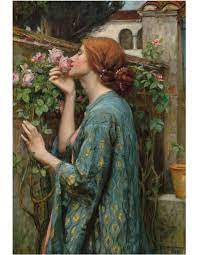Elisabeth Vigée Le Brun,Madame grand,1783
The Rococo art period has always been my favorite time frame, with its youthful pastel colors. Art in France during the 18th century has a certain aesthetic of melancholy love that shivers down my spine. Madame grand is a painting of a young aristocratic woman painted by Elisabeth Vigée Le Brun in 1783. The portrait Madame grand expresses the French love for beauty and high-class society.
This portrait is of Catherine Noël Grand, a young French aristocrat blessed with beauty, but no brains. She was creative and could play the piano, hence the music sheet she's holding in her portrait. The painting is sometimes referred to as the music lesson because of the sheet of music. When Madame Grand appeared in Paris with her husband, George François Grand, she caught the attention of wealthy men and Vigée Le Brun. We are not sure who commissioned her portrait to be painted by Vigée Le Brun; it could have been her herself or one of the many men she attracted. Needless to say, it's a captivating painting.
Vigée Le Brun lined this piece with directional lines, pulling the viewer's eyes around the oil painting. The composition of the painting is that of a triangle. First thing I noticed in this painting were her eyes above her flushed cheeks. Her eyes point to the ribbon on top of her head. The ribbon points to the left where we follow the slope of the couch to her bent arm holding music sheets. The corner of the music sheet helps to guide the viewer's eyes to the deep shadowed part of the body that looks as if it's receding into the mid-ground.
The woman seems more like a whimsical dream with the soft colorful undertones of her skin rather than appearing verisimilitude. The portrait portrays the figure in the foreground with a youthful face and almost more childlike with all the boys placed on her person. Her painted expression captures the personality of a young, ill-educated woman who's talented in the arts. Her big round-shaped doe eyes still have a gleam of childlike behavior. She's soft and beautiful, a great example of French rococo pride.
“Noël Catherine Verlée, Madame Grand.” Madame Guillotine, 2 May 2020, https://www.madameguillotine.co.uk/2020/05/02/noel-catherine-verlee-madame-grand/.
“Madame Grand (Noël Catherine Vorlée, 1761–1835) - Élisabeth Louise Vigée Le Brun - Google Arts & Culture.” Google, Google, https://artsandculture.google.com/asset/madame-grand-no%C3%ABl-catherine-vorl%C3%A9e-1761%E2%80%931835-%C3%89lisabeth-louise-vig%C3%A9e-le-brun/VgGVzbNUlGoZmQ?hl=en.


I absolutely love your taste in art and how you describe it. I was really excited about this class because I love art and always wanted to understand it more. I will be commenting on your blog again. I also love this piece. The eyes look so moist. The see through sleeve exquisit. The frayed edges on the bow in her hair. I even like the texture on the chair. The wood detail is perfectly three dimensional and the emerald green velvet texture on the chair is perfectly done. Like how does anyone even paint that? It reminds me of the Duchess of Beaufort, Portrait c.1775-1780 (oil on canvas), Gainsborough, Thomas (1727-88) Thomas Gainsborough. I love this era of women and art. Women used to do amazing things to their hair like put full toys ships in it. What a fun time to be alive if one was wealthy.
ReplyDeletehttps://fineartamerica.com/featured/portrait-of-the-duchess-of-beaufort-thomas-gainsborough.html
I never really was interested in this type of art but I like it. The background of the painting is very interesting, and I would love to learn more. The contrast of the color between Madame Grand, and the surroundings make the colors painted of her bright.
ReplyDelete